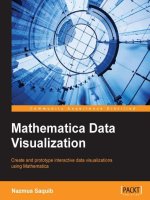IT training smart data platform khotailieu
Bạn đang xem bản rút gọn của tài liệu. Xem và tải ngay bản đầy đủ của tài liệu tại đây (4.47 MB, 71 trang )
Co
m
pl
ts
of
Yifei Lin & Wenfeng Xiao
en
How Enterprises Survive in the
Era of Smart Data
im
Implementing
a Smart Data
Platform
Implementing a Smart
Data Platform
How Enterprises Survive in the
Era of Smart Data
Yifei Lin and Wenfeng Xiao
Beijing
Boston Farnham Sebastopol
Tokyo
Implementing a Smart Data Platform
by Yifei Lin and Wenfeng Xiao
Copyright © 2017 O’Reilly Media, Inc. All rights reserved.
Printed in the United States of America.
Published by O’Reilly Media, Inc., 1005 Gravenstein Highway North, Sebastopol, CA
95472.
O’Reilly books may be purchased for educational, business, or sales promotional use.
Online editions are also available for most titles ( For more
information, contact our corporate/institutional sales department: 800-998-9938 or
Editor: Nicole Tache
Production Editor: Melanie Yarbrough
Copyeditor: Jasmine Kwityn
Proofreader: Charles Roumeliotis
Interior Designer: David Futato
Cover Designer: Karen Montgomery
Illustrator: Rebecca Demarest
First Edition
May 2017:
Revision History for the First Edition
2017-05-10:
First Release
The O’Reilly logo is a registered trademark of O’Reilly Media, Inc. Implementing a
Smart Data Platform, the cover image, and related trade dress are trademarks of
O’Reilly Media, Inc.
While the publisher and the authors have used good faith efforts to ensure that the
information and instructions contained in this work are accurate, the publisher and
the authors disclaim all responsibility for errors or omissions, including without
limitation responsibility for damages resulting from the use of or reliance on this
work. Use of the information and instructions contained in this work is at your own
risk. If any code samples or other technology this work contains or describes is sub‐
ject to open source licenses or the intellectual property rights of others, it is your
responsibility to ensure that your use thereof complies with such licenses and/or
rights.
978-1-491-98346-1
[LSI]
Table of Contents
1. The Advent of the Smart Data Era. . . . . . . . . . . . . . . . . . . . . . . . . . . . . . 1
Three Elements of the Smart Data Era: Data, AI, and Human
Wisdom
2
2. Challenges of the Smart Data Era for Enterprises. . . . . . . . . . . . . . . . . 5
Challenges in Data Management
Challenges in Data Engineering
Challenges in Data Science
Challenges in Technical Platform
6
7
8
9
3. The Advent of Smart Enterprises and SmartDP. . . . . . . . . . . . . . . . . . 11
4. Data Management, Data Engineering, and Data Science Overview. 13
Data Management
Data Engineering
Data Science
13
16
30
5. SmartDP Solutions. . . . . . . . . . . . . . . . . . . . . . . . . . . . . . . . . . . . . . . . . . 31
Data Market
Platform Products
Data Applications
Consulting and Services
31
32
34
34
6. SmartDP Reference Architecture. . . . . . . . . . . . . . . . . . . . . . . . . . . . . . 37
Data Layer
Data Access Layer
Infrastructure Layer
39
40
41
iii
Data Application Layer
Operation Management Layer
44
45
7. Case Studies. . . . . . . . . . . . . . . . . . . . . . . . . . . . . . . . . . . . . . . . . . . . . . . 47
SmartDP Drives Growth in Banks
Real Estate Development Groups Integrate Online and
Offline Marketing with SmartDP
Common Market Practices and Disadvantages
Methodology
Description of the Overall Plan
Conclusion
iv
|
Table of Contents
47
54
54
55
56
63
CHAPTER 1
The Advent of the Smart Data Era
The data we collect has experienced exponential growth, whether we
get it through our PCs, mobile devices, or the IoT, or from tools for
ecommerce or social networking. According to the IDC Report,
global data volume reached 8 ZB (or 8 billion TB) in 2015 and is
expected to reach 35 ZB in 2020, with an annual increase of nearly
40%. And according to TalkingData, in 2016 China was home to 1.3
billion smartphone users, accounting for tens of millions of weara‐
ble devices such as smart watches and over 8 billion sensors of dif‐
ferent kinds. Smart devices can be seen nearly everywhere and
generate data of various dimensions—anytime, anywhere.
Data accumulation has created favorable conditions for the develop‐
ment of artificial intelligence (AI). The training of machines with a
huge amount of data may generate more powerful AI. For example,
the game of Go (or “Weiqi” in Chinese) has been traditionally
viewed as one of the most challenging games due to its complicated
tactics. In 2016, Google’s program AlphaGo (with access to 30 mil‐
lion distributed data points and improved algorithms, accumulated
by users after they played Go hundreds of thousands of times)
defeated world Go champion Li Shishi, proving its No.1 Go-playing
ability. In the previous two years, AI also witnessed explosive growth
and application in the fields of finance, transport, medicine, educa‐
tion, industry, and more. It’s clear that the data accumulated by
mankind has been used to produce new intelligence, which could
aid our work, reduce costs, and improve efficiency. According to a
CB Insights report, investment funds of global AI startups also had
exponential growth during 2010 to 2015.
1
Figure 1-1. Artificial intelligence global yearly financing history, 2010–
2015, in millions of dollars (source: CB Insights)
Data accumulation and the development of AI promote and com‐
plement each other. Andrew NG, AI expert and VP & Chief Scien‐
tist of Baidu, said in a Wired article, “To draw an analogy, data is like
the fuel for a rocket. We need both a big engine (algorithm) and
plenty of fuel (data) in order to enable the rocket (AI) to be
launched.” Also, AI has brought us more application contexts such
as chatting robots and autonomous vehicles, which are generating
new data.
And now data is becoming not only bigger but also smarter and
more useful. We have entered the smart data era.
Three Elements of the Smart Data Era: Data,
AI, and Human Wisdom
Data accumulation can enable deeper insights and help us to gain
more experience and wisdom. For example, through further analysis
on mobile phone users’ behaviors, enterprises can gain more under‐
standing of their clients, including their preferences and consuming
habits, so as to gain more marketing opportunities. Additionally, AI
in itself requires the involvement of human wisdom so as to guide
the orientation of AI and increase its efficiency. For example,
AlphaGo needs to fight against professionals in the game of Go so as
to continuously enhance its Go-playing ability with the aid of
human wisdom.
2
|
Chapter 1: The Advent of the Smart Data Era
Without the continuous intervention of human wisdom, the addi‐
tion of AI to data will lose some of its value and even become inef‐
fective. Conversely, without AI, it is a challenge for humans alone to
deal with such complicated and rapidly changed data. Also, without
data, it would be impossible for AI to exist and the accumulation of
human wisdom would also slow down. Data, AI, and human wis‐
dom facilitate each other and form a forward loop.
For example, in the field of context awareness, the movements and
gestures of mobile phone users (including walking, riding, driving,
etc.) may be judged by using AI algorithms with the phones’ sensor
data. If any judgment is not accurate enough, data should be sorted
and enhanced by human intervention and algorithms should be
optimized until the result is acceptable. Also, mobile phones capable
of context awareness may provide application developers more con‐
texts and experience, such as body-building (i.e., gestures need to be
captured and the frequency/number of steps or even the place needs
to be judged in order to obtain more accurate data of users’ status),
financial risk control, logistics management, and entertainment.
Accordingly, more data would be generated. This new data may
allow human wisdom to grow quickly and AI to become more pow‐
erful. For example, it is discovered through context-awareness data
that most users keep their mobile phones in their hands when they
are using apps. Thus, does a non-handheld application context—
such as fraudulent app rating, done on non-handheld mobile
phones—mean even greater financial risk?
The three elements of the smart data era have generated incredible
value in their combined and independent actions. Enterprises that
adapt to the new era would be able to restructure their infrastruc‐
ture using data, AI, and human wisdom and accelerate the process
of exploring and realizing commercial value so as to stand out in
fierce competition. Those enterprises with slow actions would be at
a loss when they are faced with scattered and complicated data and
gradually lose their competitiveness. There is no way for them to
share the greatest benefit (i.e., value). Nevertheless, the shock of a
new era is independent of enterprise scale or industry.
In this report, we are going to list the challenges for enterprises dur‐
ing the smart data age and analyze their causes. With over five years
of industrial service experience, TalkingData has helped enterprises
find solutions to cope with the challenges of data, and to efficiently
explore the business value of data. We introduce the concept of
Three Elements of the Smart Data Era: Data, AI, and Human Wisdom
|
3
SmartDP along with the three basic capabilities that SmartDP
should possess: data management, data science, and data engineer‐
ing. Meanwhile, we also introduce the SmartDP referential frame‐
work, and detail the functions of each layer. Finally, we will take a
look at how SmartDP is adopted in real scenarios to enhance our
understanding of smart data.
4
|
Chapter 1: The Advent of the Smart Data Era
CHAPTER 2
Challenges of the Smart Data Era
for Enterprises
In the smart data era, enterprises should transform themselves from
traditional product- and technology-driven enterprises into datadriven ones. Different from traditional enterprises, data-driven
enterprises are characterized by the following aspects:
• Data is regarded as an important asset for management.
• Specific data applications are used to solve business problems.
(These applications are linked to the current data systems of
enterprises. Meanwhile, enterprise data—both self-owned and
other business-related data—are called).
• Specialized and structured data teams are set up inside the
enterprises (problems are not solved by outsourcing).
• A data-driven culture is built.
During the transition to becoming a data-driven entity, traditional
enterprises are severely challenged by business digitalization and
data capitalization. A huge amount of data is not acquired in an
effective manner due to the lack of business digitalization. For
example, users’ click event data on websites, the interaction data of
app users, user subscription and browsing data on WeChat public
platforms, customer visit data of offline stores, and other businessrelated data may not be acquired or used. Nowadays, the prevailing
mobile phones (e.g., iPhone, Samsung Galaxy, etc.) are generally
equipped with 15 or more sensors, including ambient light condi‐
5
tion perception, acceleration, terrestrial magnetism, gyroscope, dis‐
tance, pressure, RGB light, temperature, humidity, Hall coefficient,
heartbeat and fingerprint, and more. If all sensors are activated, each
mobile phone could acquire up to 1GB of data per day. Although
this data can truly present the contexts of mobile users, most is
abandoned.
With both the scale and dimensions of data rapidly increasing,
enterprises are unable to effectively prepare and gain insight from
data, making it hard for them to support business policymaking.
According to a report of BCG (Boston Consulting Group) in 2015,
only 34% of the data generated by financial institutions (with a rela‐
tively higher degree of IT support) was actually used. And according
to a survey report of Experian Data Quality, in 2016 nearly 60% of
American enterprises could not actively sense or deal with the issue
of data quality and did not have fixed departments or roles responsi‐
ble for managing data quality. There is clearly still a long way to go
in terms of managing complicated data. If not effectively utilized, a
large amount of data would not be asset-oriented and thus would
not produce any value, which means huge costs for enterprises in
turn.
Enterprises struggle with these challenges for a variety of reasons:
some have no advanced technical platform, some are deficient in
data management, some have not built standard data engineering
systems, and some others simply lag behind in terms of their under‐
standing of the value of data science. All these have hampered the
transformation of traditional enterprises toward intelligent, datadriven ones. Let’s look at each of these challenges more closely.
Challenges in Data Management
First, enterprises are faced with a series of challenges that need be
solved by proper data management. These challenges include:
• Numerous internal systems and inconsistent data might cause
confusion. Take gender, for example. It may differ in a CRM
system (actual gender in the fundamental demographics), a
marketing system (e.g., a husband may sometimes purchase
female-oriented goods in order to send a gift to his wife), and a
social networking system (e.g., unique sexual orientation). If
6
|
Chapter 2: Challenges of the Smart Data Era for Enterprises
gender is purely regarded as a consistent attribute across sys‐
tems, errors may occur.
• The descriptive information of data (metadata) is controlled by
different people in different departments of an enterprise, and
fails to be shared across channels. Even for the same data, the
understanding how it may be different due to the possible exis‐
tence of varying standards. For example, the HR Department of
an enterprise would maintain a list of employees and their
addresses (home addresses) but the Administration Department
may update an address to send employee benefits for the holi‐
days so that such benefits can be properly delivered. In such
cases, “home addresses” are changed to “mailing addresses.”
However, both parties believe that the correct addresses have
been given. Another example is ecommerce. For the number of
ecommerce apps activated, the Marketing Department may
believe that apps are activated after they are started for the first
time but the Product Department may think that apps are acti‐
vated once they are used to make a purchase for the first time.
• It is difficult to effectively integrate the data that is distributed
on the enterprise’s external platforms. For example, the data
acquired by a WiFi probe installed in the store of an enterprise
and the data accumulated on each third-party media platform
(such as the WeChat public platform) may possibly supplement
client data dimensions. However, the IDs used for client followup fail to be connected. As a result, the data of all platforms is
unable to sync, thus greatly reducing the value of data.
Challenges in Data Engineering
Second, enterprises encounter challenges when data and the current
business flow don’t form a complete value chain. In such a case, data
engineering is required to solve the issue. These challenges include:
• Lack of explicit data standards and specifications. Each depart‐
ment or system gives different definitions or descriptions of the
same data and acquires data of varying quality, or even misses
some data in acquisition, which burdens the data processing
later.
• Lack of explicit definitions about job functions and engineering
of data. Data management work is assigned to people at ran‐
Challenges in Data Engineering
|
7
dom, typically IT personnel, data architects, data analysts, or
data scientists. Also, there are instances when no specific rights
and responsibilities are designated to those working with data.
As a result, it becomes difficult to conduct continuous data
management operation and form a closed loop.
• Increasing data application contexts and the data processed by
various data applications leads to redundant and ineffective data
preparation and analysis, thus impacting the efficiency of deliv‐
ering the data applications.
Challenges in Data Science
Third, shifting practical issues to automatic decisions that can be
supported by data also introduces challenges, which need to be
solved by data science. These challenges include:
• Shortage in data science professionals. It seems quite difficult to
apply the most cutting-edge technologies of data science as
there are not many talents in the field of data science. McKinsey
estimated that 190,000 additional data scientists are needed in
the United States by 2018, and that figure would be even bigger
in China.
• If the quality of data is unstable, it is difficult to see its value,
even if the algorithms used on that data are in working order.
According to an EDQ report, the biggest factors that affect data
quality include incomplete or lost data, obsolete information,
repeated data, inconsistent data, and flawed data (e.g., contain‐
ing spelling errors). In order to solve these problems, systematic
considerations should be made. Thus, it would be difficult for
these problems to be solved only by stopgap measures.
• Enterprises are too eager for quick success and instant benefits
to make long-term investments in the data field. Data science is
never a cure-all and it is difficult for it to solve all problems in
one stroke. In most cases, continuous investment is required.
Gradual improvements should be made with algorithm optimi‐
zation and iterative models that cover each link of data engi‐
neering, including data acquisition, organization, analysis, and
action. Take the marketing and launching of applications for
example. The audience for one round of the launch should be
adjusted according to the results of the previous round. The
8
|
Chapter 2: Challenges of the Smart Data Era for Enterprises
launch process can be improved only after several rounds of
iteration.
Challenges in Technical Platform
Finally, the data management, data engineering, and data science
teams also present a challenge to the technical platform. The chal‐
lenges to the platform include:
• Increasing scale and dimensions of data. In the past, the data
acquired by enterprises was mainly derived from emails, web
pages, call centers, and so on. Currently, data sources also
include mobile phone applications, sensors (such as iBeacon),
social media, VR/AR devices, automobiles, and smart home
appliances. The data being obtained by enterprises is becoming
more and more varied, and helps these organizations capture a
huge amount of data of various dimensions.
• Increasing data sources and types. In addition to traditional
structured data, semi-structured data (such as JSON), nonstructured data (such as videos, images, and texts) and flow type
data (such as click blogs on websites) should also be processed.
In addition to the enterprise’s own data stored in internal CRM
systems and public platforms such as WeChat, third-party data
purchased by enterprises from the data trading market may also
need to be processed.
• Continuously changing data formats. This is the most common
challenge in the current data ecology. For example, an upstream
data provider may fail to notify all downstream data providers
when it adjusts a data format. Additionally, a change in data
dimensions upon acquisition may often cause challenges. For
instance, a particular sensor might be added to a newly released
smart mobile phone, which may require the addition of new
fields in the data format collected.
• As enterprises gradually shift their demands for data analytics
from simple presentation to backend business support, there is
an increasingly higher demand for real-time performance of the
data platform. For example, many results of real-time data sta‐
tistics now show changes in the real-time customer flow of apps
or offline stores and tell us when there are the most visits or
which public platform or store is the most active. Also, such
Challenges in Technical Platform
|
9
results can be used to analyze the flow or number of clients at
individual hours of a day. This is of great significance for the
time management and resource allocation of websites.
10
|
Chapter 2: Challenges of the Smart Data Era for Enterprises
CHAPTER 3
The Advent of Smart Enterprises
and SmartDP
Despite the difficulty of transition in the smart data era, many
emerging enterprises rose above others and enhanced their competi‐
tiveness with data, which shocked traditional enterprises in all fields.
According to the Mobile Internet Report 2016 issued by A16Z, the
data giants represented by GAFA (Google, Amazon, Facebook, and
Apple) have accumulated competitive advantages in the fields of
data and technology and earned more than three times the revenue
of Wintel (Microsoft and Intel) on an annual basis. In turn, they are
changing the forms and modes of traditional industries through
data and technology, including retail, media distribution, automo‐
tive, and so on.
These new pioneers share something in common: they have imple‐
mented a data-driven business model and a sophisticated data asset
management system. Furthermore, they are able to drive contextual
applications by using data, as well as explore and convert commer‐
cial value in an efficient manner. Such enterprises that have built a
data-driven culture are called smart enterprises. Characteristics of
smart enterprises include the following:
• Their flexible technical platforms and data science capacity can
sufficiently support huge data scale, large data dimensions,
complicated data types, and flexible data formats. These plat‐
forms also enable quick insights from data, which increases the
efficiency of various data application contexts.
11
• Their unified data management strategy can be used to manage
data views that are consistent across enterprises, efficiently
gather data (including self-owned and third-party data), and
also efficiently output data and data services.
• Their end-to-end data engineering capacity can support data
management for the business and help form a closed loop that
continuously optimizes business operations.
Smart enterprises are the companies that are armed with these three
capabilities.
In order to become data-driven, smart enterprises need a new plat‐
form to support them, a platform that promotes an environment
that is focused on data. This platform is called SmartDP (smart data
platform). SmartDP refers to a platform that explores the commer‐
cial value of data based on smart data applications, and enables
proper data management, data engineering, and data science.
Comprised of a set of modern data solutions, SmartDP helps enter‐
prises build an end-to-end closed data loop, from data acquisition to
decision to action, in order to provide the capacity for flexible data
insight and data value mining as well as flexible and scalable support
for contextual data applications. As we’ll see later in this report,
adopting SmartDP can improve enterprises’ data management, data
engineering, and data science capabilities. We’ll now review each of
these aspects in general terms.
12
|
Chapter 3: The Advent of Smart Enterprises and SmartDP
CHAPTER 4
Data Management,
Data Engineering,
and Data Science Overview
Data Management
Data management refers to the process by which data is effectively
acquired, stored, processed, and applied, aiming to bring the role of
data into full play. In terms of business, data management includes
metadata management, data quality management, and data security
management.
Metadata Management
Metadata can help us to find and use data, and it constitutes the
basis of data management.
Normally, metadata is divided into the following three types:
• Technical metadata refers to a description of a dataset from a
technical perspective, mainly form and structure, including data
type (such as text, JSON, and Avro) and data structure (such as
field and field type).
• Operational metadata refers to a description of a dataset from
the operation perspective, mainly data lineage and data summa‐
ries, including data sources, number of data records, and statis‐
tical distribution of numerical values for each field.
13
• Business metadata refers to a description of a dataset from the
business point of view, mainly the significance of a dataset for
business users, including business names, business descriptions,
business labels, data-masking strategies.
Metadata management, as a whole, refers to the generation, moni‐
toring, enrichment, deletion, and query of metadata.
Data Quality Management
Data quality is a description of whether the dataset is good or bad.
Generally, data quality should be assessed for the following charac‐
teristics:
• Integrity refers to the integrity of data or metadata, including
whether any field or any field content is missing (e.g., the home
address only contains the street name, or no area code is
included in the landline number).
• Timeliness or “freshness” refers to whether data is delayed too
long from its generation to its availability and whether updates
are sufficiently frequent. For example, real-time high-density
data updates are necessary for the status monitoring of servers
to ensure an alarm can be sent and dealt with in a timely man‐
ner in case of any problem to avoid more serious problems. To
track the number of new mobile app users, Daily Active Users
(DAUs) should be updated once a day in general cases. How‐
ever, the increase in the number of new users is rarely studied.
• Accuracy refers to whether data is erroneous or abnormal—for
example, incorrect phone numbers, having the wrong number
of digits in an ID number, and using the wrong email format.
• Consistency involves both format (e.g., whether the telephone
number conforms to MSISDN specifications) and logic across
datasets. Sometimes, it may be OK from the point of view of a
single dataset. However, problems would occur if two datasets
are interconnected. For example, inconsistent gender data may
appear in the internal system of an enterprise. The data may
show male in the CRM system but female in the marketing sys‐
tem. Data should be further understood so as to adjust data
descriptions and ensure data visitors are not confused.
14
| Chapter 4: Data Management, Data Engineering, and Data Science Overview
Data quality management involves not only index description and
monitoring of data integrity, timeliness, accuracy, and consistency
but also the improvement of data quality by means of data organiza‐
tion.
Sometimes the problems of data quality are not so conspicuous and
there is no way to make judgments only by statistical figures—in
these cases, domain knowledge is required. For example, when the
Tencent data team performed a statistical analysis of SVIP QQ users,
it was discovered that the age group at 40 years old was the largest of
such users, far more than the ages of 39 and 41. It was thus guessed
that the group had an increased opportunity for online communica‐
tion with their children or more free time. However, this did not
align with the domain knowledge, which was not convincing. Fur‐
ther analysis revealed there were an inordinate number of users with
a birthdate of January 1, 1970—the default birthdate set by the sys‐
tem—and that this is what had accounted for the high number of
40-year-old users (the study was conducted in 2010). Therefore,
data operators should have a deep understanding of data and obtain
the domain knowledge that is not known by others.
Data Security Management
Data security mainly refers to the protection of data access, use, and
release processes, which includes the following:
• Data access control refers to the control of data access authority
so that data can be accessed by the personnel with proper
authorization.
• Data audit refers to the recording of all data operations by log
or report so as to be traceable if needed.
• Data mask refers to the deletion of some data according to pre‐
set rules (especially the parts concerning privacy, such as per‐
sonally recognizable data, personal private data, and sensitive
business data) so as to protect data.
• Data tokenization refers to the substitution of some data content
according to preset rules (especially sensitive data content) so as
to protect data.
Data security management, therefore, entails the addition, deletion,
modification, and monitoring of data, which aims to enable users to
Data Management
|
15
access data in a convenient and efficient manner while ensuring data
security.
Data Engineering
Most traditional enterprises are challenged by poor implementation
of data acquisition, organization, analytics, and action procedures
when they transform themselves for the smart era. Thus, it is urgent
that enterprises build end-to-end data engineering capacity
throughout their data acquisition, organization, analytics, and
action procedures, so as to ensure a data- and procedure-driven
business structure, rational data, and a closed-loop approach, and
realize the transformation from further insight into commercial
value of data. The search engine is the simplest example. After a
search engine makes a user’s interactive behavior data-driven, it can
optimize the presentation of the search result so as to improve the
user’s searching experience and attract more users to it. This optimi‐
zation is done according to duration of the user’s stay, number of
clicks, and other conditions. Additionally, it can generate more data
for optimization. This is a closed loop of data, which can bring
about continuous business optimization.
In the smart data era, due to the complexity of data and data appli‐
cation contexts, data engineering needs to integrate both AI and
human wisdom to maximize its effectiveness. For example, a search
engine aims to solve the issue of information ingestion after the
surge in the volume of information on the internet. As tens of mil‐
lions of web pages cannot be dealt with using manual URL classified
navigation, algorithms must be used to index information and sort
search results according to users’ characteristics. In order to adapt to
the increasingly complex web environment, Google has been gradu‐
ally improving its search ranking intelligence, from the earliest Pag‐
eRank algorithm, to Hummingbird in 2013 and the addition of the
machine learning algorithm RankBrain as the third-most important
sorting signal in 2015. There are over 200 sorting signals for the
Google search engine; and variant signals or subsignals may be in
the tens of thousands and are continuously changing. Normally, new
sorting signals need to be discovered, analyzed, and evaluated by
humans in order to determine their effects on the sorting results.
Thus, even if there are powerful algorithms and massive data,
human wisdom is absolutely necessary and undertakes a key role in
efficient data engineering.
16
| Chapter 4: Data Management, Data Engineering, and Data Science Overview
Implementation Flow of Data Engineering
In terms of implementation, data engineering normally includes
data acquisition, organization, analytics, and action, which form a
closed loop of data (see Figure 4-1).
Figure 4-1. Closed loop of data processing (figure courtesy of Wenfeng
Xiao)
Data Acquisition
Data acquisition focuses on generated data and captures data into
the system for processing. It is divided into two stages—data harvest
and data ingestion.
Different data application contexts have different demands for the
latency of the data acquisition process. There are three main modes:
Real time
Data should be processed in a real-time manner without any
time delay. Normally, there would be a demand for real-time
processing in trading-related contexts. For example:
Data Engineering
|
17
• For online trade fraud prevention, the data of trading par‐
ties should be dealt with by an anti-fraud model at the fast‐
est possible speed, so as to judge if there is any fraud, and
promptly report any deviant behavior to the authorities.
• The commodities of an ecommerce website should be rec‐
ommended in a real-time manner according to the histori‐
cal data of clients and the current web page browsing
behavior.
• Computer manufacturers should, according to their sales
conditions, make a real-time adjustment of inventories,
production plans, and parts supply orders.
• The manufacturing industry should, based on sensor data,
make a real-time judgment of production line risks,
promptly conduct troubleshooting, and guarantee the pro‐
duction.
Micro batch
Data should be processed by the minute in a periodic manner. It
is not necessary that data is processed in a real-time manner.
Some delay is allowed. For example, the effect of an advertise‐
ment should be monitored every five minutes so as to deter‐
mine a future release strategy. It is thus required that data
should be processed in a centralized manner every five minutes
in aggregate.
Mega batch
Data should be processed periodically with a time span of sev‐
eral hours, without a high volume of data ingested in real time
and a long delay in processing. For example, some web pages
are not frequently updated and web page content may be
crawled and updated once every day.
Streaming data is not necessarily acquired in a real-time manner. It
may also be acquired in batches, depending on application context.
For example, the click event stream of a mobile app is uploaded in a
continuous way. However, if we only wish to count the added or
retained stream in the current day, we only need to incorporate all
click-stream blogs in that day in a document and upload them to the
system by means of a mega batch for analytics.
18
|
Chapter 4: Data Management, Data Engineering, and Data Science Overview









